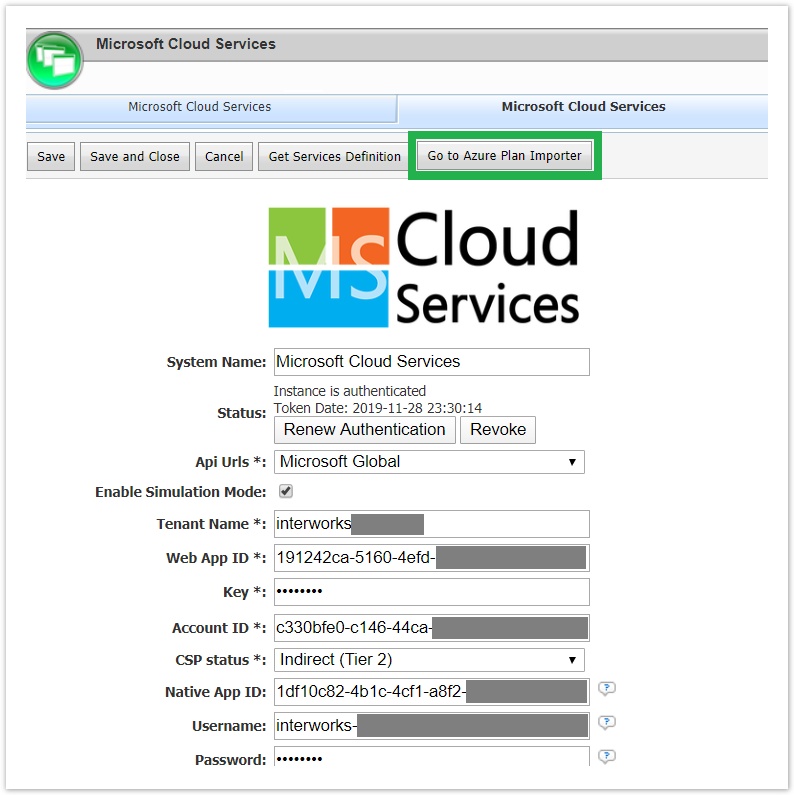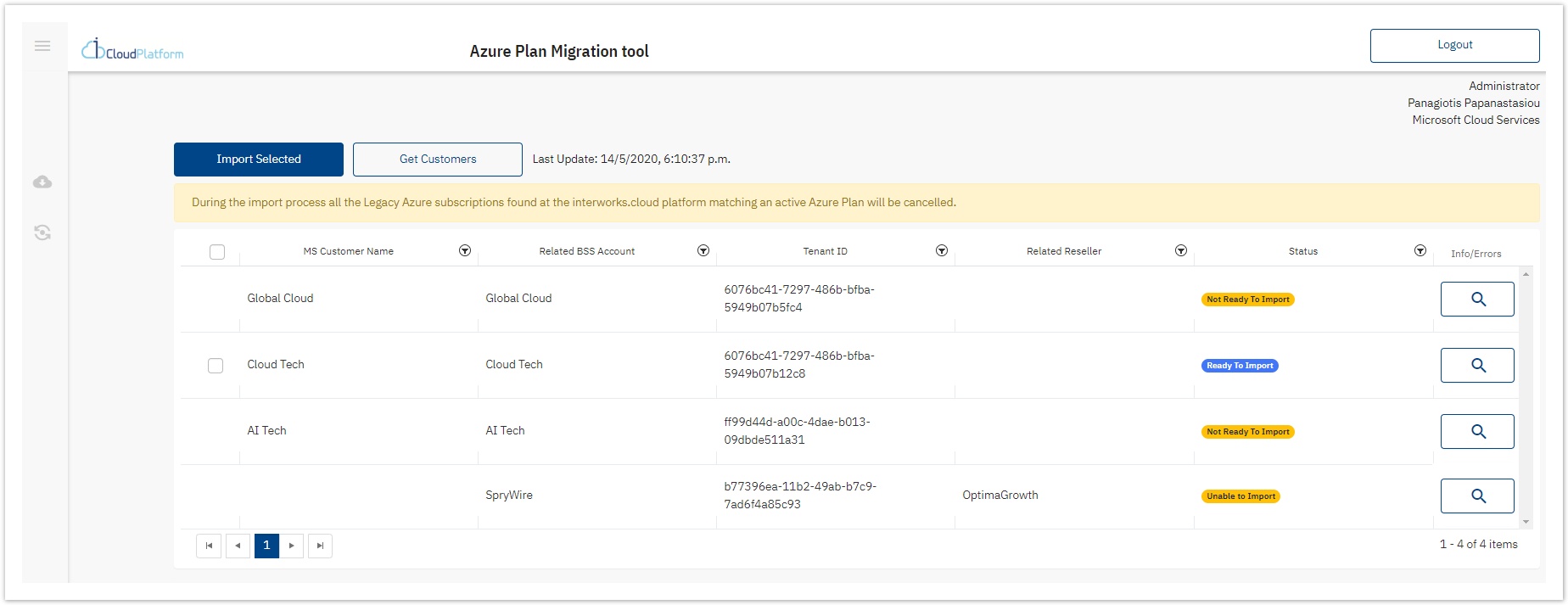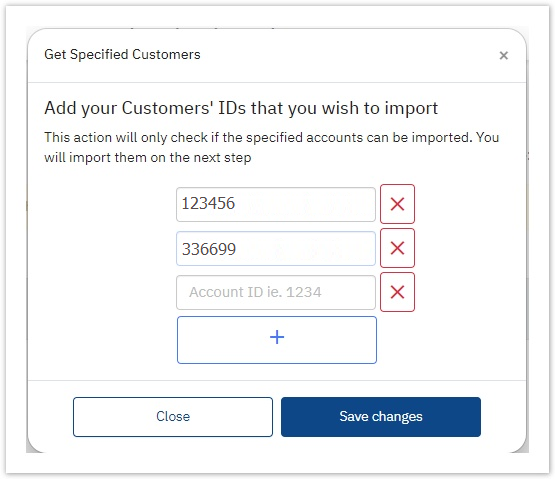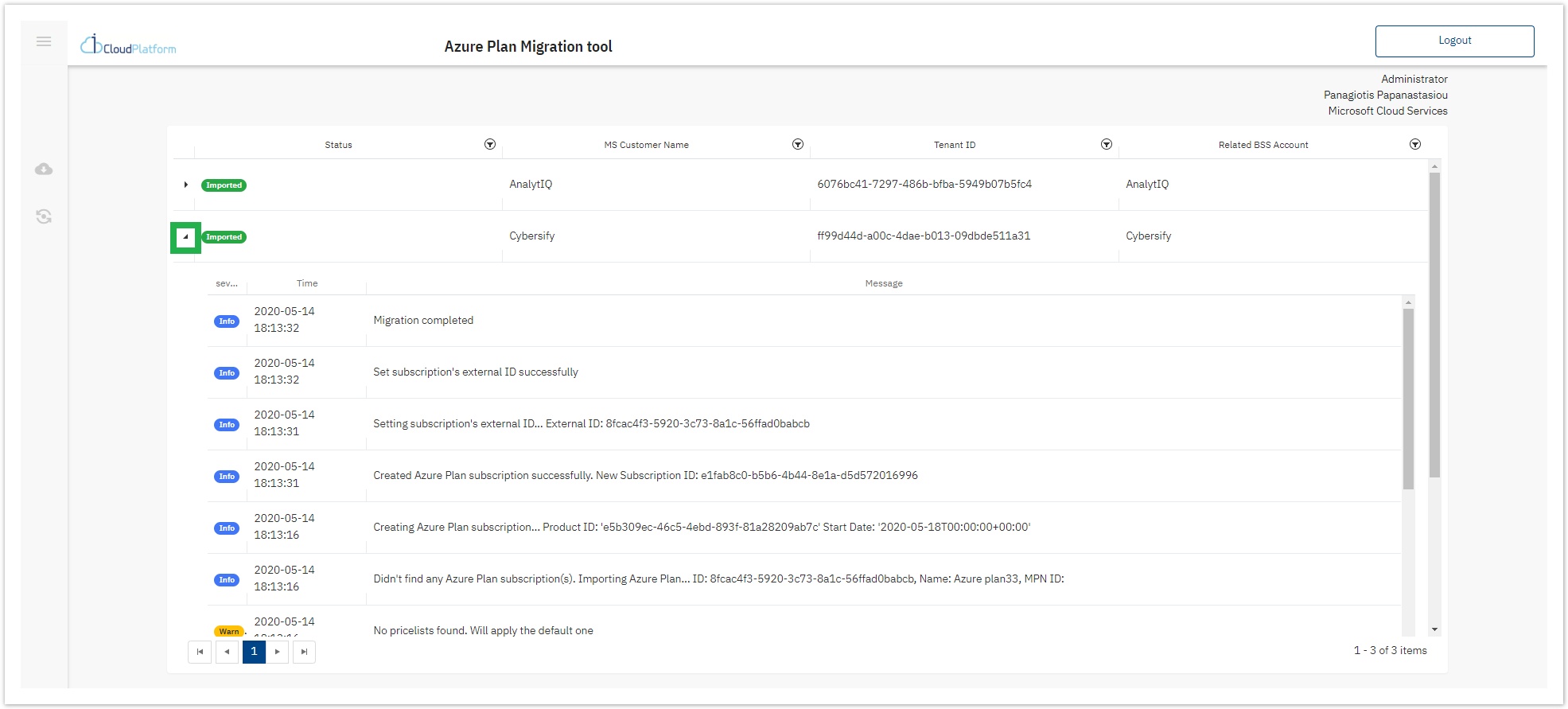Migrating your Existing Azure Plan Subscriptions in BSS OLD-Deprecated
Apostolos Karakaxas
Panagiotis Papanastasiou
The Azure Plan Importer tool will allow you to migrate all customers' Azure Plans subscriptions that have already been created inside the Microsoft Partner Center(MPC) in your BSS. Using this tool you will be able to import both Azure plan subscriptions that were created during the transition from the legacy Azure subscriptions but also subscriptions that were created for customers never used Azure in the past.
The tool is located on each "Microsoft Cloud Services" instance on our BSS platform, as a button called "Azure Plan Importer".
Access the Tool
To access the "Azure Plan Importer" tool, navigate to BSS Setup > Administration > System Options > Applications Setup > Microsoft Cloud Services > Settings (button) and select the instance tab you wish to run the tool. Then, click the "Go to Azure Plan Importer" button, as depicted below.

You are being redirected on a different web-browser tab where the "Go to Azure Plan Importer" opens.
Navigation & Tools
Inside the Azure Plan Importer tool, you are provided with the tools necessary to start immediately the migration/import of the instance's Azure Plan subscriptions. You are provided with:
- The list's column filters, that will be populated with the Microsoft(MS) Tenants, that have an Azure Plan on MPC and not on our system.
- A button named "Get Specific Customers", for collecting specific MS Tenants that own Azure plan subscriptions that haven't been imported yet in your BSS.
- A button named "Get Customers", for collecting the MS Tenants that own Azure plan subscriptions that haven't been imported yet in your BSS.
- Another button named "Import Selected", for the initialization of the import process.
- The "Logout" button which when clicked, logs you out of the tool of the chosen instance.

Furthermore, you will find two main navigation tabs on the left-middle part of the screen (inside the collapsible menu), namely the "Current State" tab and the "Results" tab.
Tab | Explanation |
|---|---|
| The first tab is where the import matching and initiation takes place for your MS Tenants' Azure Plan subscriptions towards our BSS. |
| The second tab is where you can examine the import results. |
In the following analysis, we shall examine first the Current State tab along with all its functionalities, and then the Results tab examination will follow.
Current State Tab
Inside the "Current State" tab you can find a table list with which you can manage your customers' new Azure Plan subscription imports.
Each time you wish to insert those Plan subscriptions to BSS, the tool acquires all your existing MS Tenants and their corresponding Plan subscriptions via the Get Customers button, which essentially begins a "communication" (API call) with Microsoft to collect everything relative to the instance that you are currently in. However, if you wish to insert certain Plan subscriptions to BSS, the tool can also acquire only your specified existing MS Tenants and their corresponding Plan subscriptions via the Get Specific Customers button which, in the same way as previously mentioned, collects the specified MS Tenants relative to the instance that you are currently in. Then the results from either of these two distinct "communications" (for specific or all customers) are depicted on the tool's list to be imported. Apart from Microsoft's customer name, related BSS account, tenant id, and related reseller, we also depict their pre-import status as well as the status of their imported Plan subscriptions.
Νext to the Get Specific Customers button, is an indicator named "Last Update" for displaying the last time you ran this action. For BSS users who have never run the Get Customers process before, there will be no information for the "Last Update", as depicted in the image above.
Retrieve Azure Plan Subscriptions - "Get Customers" Action
After opening the importers' tool from the corresponding instance and subsequently clicking the Get Customers button, the tool retrieves all the customers and populates the table list for the following two scenarios:
- For a direct CSPs the list will be populated with all the synchronized BSS accounts(on the selected instance) that do not have already an Azure Plan subscription in BSS, yet contain available Azure Plans on their corresponding MS Tenants' accounts in order to import them.
- For indirect CSPs the list will be populated with all the synchronized BSS accounts(on the selected instance) that do not have already an Azure Plan subscription in BSS, yet contain available Azure Plans on their corresponding MS Tenants' accounts, per reseller, in order to import them. This means that, for example, if an MS Tenant has two Azure Plans which are managed by two different resellers, you will witness in the table list two almost identical rows in terms of the "MS Customer Name" but with different "Related Reseller" names.
Therefore, each line in the table list corresponds to an Azure plan subscription that needs to be imported.
Note: the import tool will also import new Azure plans that haven't been created from transitioning from the legacy Azure.

- Checkboxes: For the selection of each MS Tenant you want to import his Azure Plan. Are used either for a distinct selection of one or more customers to be imported.
In case an import is under the Status: "Pending" or "Failed To Import", there will be no checkbox for selection. Also, the rows with Status: "Not Ready To Import" and "Unable To Import" have their check-boxes disabled in order to prevent any import attempts prior to fixing them. - MS Customer Name: This column will depict the name of the existing account on Microsoft Partner Center. Column filtering can be used.
- Related BSS Account: This column will show the BSS account name that is found in our BSS for the specific reseller or direct customer.
- Tenant Id: The MS Tenants' account id. Column filtering can be used.
- Related Reseller: This column displays the related reseller account in case the Azure Plan subscription is related to an indirect reseller.
- Status: This column displays information regarding whether an Azure plan subscription can be imported or not.
Status States: | Status States' Explanation: |
|---|---|
| Microsoft Tenant's Azure Plan is ready for import. The customer is not yet synced with our BSS. It is the initial status before import. |
| The import has been added in the queue. |
| Microsoft Tenant's Azure Plan import has failed and cannot be merged in our BSS. You are able to click on the "Get Customers" button and try again. |
| Microsoft Tenant's Azure Plan cannot be synced on BSS. Usually, this status is displayed when our tool is not able to identify the Plan that needs to be imported, because of MPN ID issues or the existence of more than one BSS accounts for the same Azure Plan, In these cases, we will display that status with the corresponding details that will help you to resolve the issue. Here we will also display any other error that occurred and the importing is not possible. |
| The import is in progress and status will be changed when import gets completed. |
| In case of any Microsoft API call error, this status will be displayed. In such cases, you are able to click on the "Get Customers" button and try again. Detailed information should be visible on the "Information/Errors" column. |
| This status appears in case the importing procedure has been successfully completed on a previous run of our tool and the Azure Plan has been imported on the BSS account. |
- Information/Errors: On this column, by clicking on the "View"
 button, a pop-up window opens containing the migration details between our BSS and MS Partner Center. More specifically, you will find information related to whether a matching occurs between our BSS and MS partner Center or not, for the particular customer, before the initialization of the import process. You are also able to review all the account-based details after the importing procedure or any error that may occur before attempting to import an MS account's Azure Plan that cannot be imported temporarily. Depending on the case, the pop-up window will look like the following examples:
button, a pop-up window opens containing the migration details between our BSS and MS Partner Center. More specifically, you will find information related to whether a matching occurs between our BSS and MS partner Center or not, for the particular customer, before the initialization of the import process. You are also able to review all the account-based details after the importing procedure or any error that may occur before attempting to import an MS account's Azure Plan that cannot be imported temporarily. Depending on the case, the pop-up window will look like the following examples:
| Views | Messages | |
Ready To Import |
"The Azure Plan with ID '...' and Name '...' and MPN ID '...'. Interpretation: This message indicates that everything is in order for that Azure Plan to be imported/migrated to our BSS platform. | |
Unable To Import |
Message from Microsoft usually due to API Error: There is no reseller relationship set between the partner and the customer, since a customer with Tenant id "..." was not found. Common Solution: In such cases, please re-run the "Get Customers" process. | |
Not Ready To Import |
Display of errors related with MPN ID issues or the existence of more than one BSS accounts for the same Azure Plan. Common Solution: In such cases, please check whether the BSS account MPN ID is linked with the corresponding MS account MPN ID. | |
Retrieve Specific Azure Plan Subscriptions - "Get Specific Customers" Action
After opening the importers' tool from the corresponding instance and subsequently clicking the Get Specific Customers button, a pop-up window opens up and requests the Customers' IDs (BSS Account IDs) that you wish to import.

As a result, after submitting the specific Customers' IDs that you wish to import, the tool can retrieve those customers and populate the table list for the following two scenarios:
- For a direct CSPs the list will be populated with the specified synchronized BSS accounts(on the selected instance) that do not have already an Azure Plan subscription in BSS, yet contain available Azure Plans on their corresponding MS Tenants' accounts in order to import them.
- For indirect CSPs the list will be populated with the specified synchronized BSS accounts(on the selected instance) that do not have already an Azure Plan subscription in BSS, yet contain available Azure Plans on their corresponding MS Tenants' accounts, per reseller, in order to import them. This means that, for example, if an MS Tenant has two Azure Plans which are managed by two different resellers, you will witness in the table list two almost identical rows in terms of the "MS Customer Name" but with different "Related Reseller" names.
Therefore, each line in the table list (depending on the specific customer IDs that you have added) corresponds to an Azure plan subscription that needs to be imported.
For the rest of the details concerning the analysis of the table list, please go to the previous section of this page named "Retrieve Azure Plan Subscriptions - 'Get Customers' Action".
Importing the Azure Plan Subscriptions
Once you have selected the customers that you wish to import from the list, you can proceed with the actual import by clicking on the Import Selected button. The import process begins its execution. The customers' rows, that were chosen for import, will have their status changed from "Ready To Import" to "Import In Progress" or "Pending Import"(depending on the amount of chosen customers currently in the queue).

The steps of a successful import execution are:
- The Creation of a BSS Azure Plan subscription for all accounts that have been transitioned to Azure Plan through the MS Partner Center and there is no Azure Plan subscription on our BSS platform.
Please note that during the import we don't amend any access rights for the Azure plan subscription in the partner center.
- The Cancellation of all existing BSS legacy Azure subscriptions from the accounts that Azure Plans will be created instead. If these legacy subscriptions were active in the partner center for the current billing cycle (i.e. the transition to Azure plan was executed during the last billing cycle), our system will generate one last invoice for their consumption. The invoices will be generated by following the rules of the legacy Azure subscriptions.
If a customer's import has failed with Status "Failed To Import", you can re-run the import process to attempt to complete the import without errors. 
To check what is causing the error and even correct it, you can navigate to the Results page via its corresponding tab.
A log of the failed import attempt will be kept in the Results page, even after you have re-run the "Get Customers" process and then retried the import. It will look like the following image:
Importer Results Page
During or after the import, you can reach the Results page by clicking on the corresponding tab to view the import process of the customer(s) as well as the import results in terms of the steps the tool has executed. Additionally, inside that page, you will find comments on information events, warning events or error events that may occur during an import. In the following analysis, we examine the content provided on that page.

For each import of one or more customers, the list adds a new row for each customer inside the Results page.
When viewing the Results page, you will find the import results logs distributed into four main columns; "Status", "MS Customer Name", "Tenant ID" and "Related BSS Account":
- Status: This column displays the status of the importing procedure, "Imported" or "Import Failed". Column filtering can be used.
- MS Customer Name: This column displays the name of the existing account on MS Partner Center. Column filtering can be used.
- Tenant Id: This column displays the MS account id. Column filtering can be used.
- Related BSS Account: This column displays the BSS account name that was found for the specific reseller or customer.
Once you expand the account's information, by clicking the arrow located at the beginning of each row, you can review the detailed logging for each step of the importing procedure of the specific account.

The expanded logging list depicts all import's steps in a temporal sequence and presents them via three columns, which are:
- Severity: This column displays the log's event type, such as if the logged event is "Informatory", a "Warning", or a "Failure".
- Time: This column displays the time each import event was logged.
- Message: This column displays each event's message during the whole import process.
The messages within the expanded logging list are very user friendly and provide clear information about each import event's actions.









